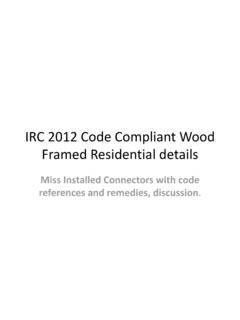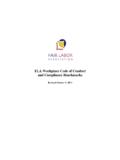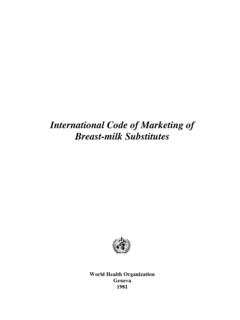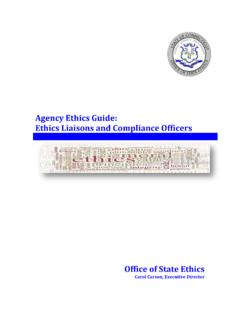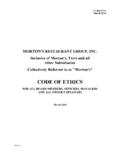Transcription of 2012 IBC Mixed Occupancies final
1 2012 IBC Mixed Occupancies Copyright 2013 International Code Council 1099H12 / 1099 PDF1212012 IBCM ixed Occupancies2012 IBCM ixed OccupanciesBased on the 2012 International Building Code (IBC )AccreditationAccreditation The International Code Council has been accredited as an Authorized Provider by the International Association for Continuing Education and Training (IACET). As a result of their Authorized Provider accreditation status, ICC is authorized to offer IACET CEUs for its programs that qualify under the ANSI/IACET Standard. You will obtain full CEUs for this course, if you actively participate in the training activities and stay for the entire session.
2 Evidence of this will be the sign out IBC Mixed Occupancies2 DescriptionDescription This course provides an overview of the 2012 IBC Section 508 provisions for the application of the code requirements addressing Mixed occupancy buildings. Other code provisions applicable to an understanding of Mixed Occupancies will also be addressed. 2012 IBC Mixed Occupancies3 GoalGoal This seminar is designed to familiarize and assist code officials in locating, describing and applying applicable code requirements of the IBC regarding Mixed Occupancies . 2012 IBC Mixed Occupancies42012 IBC Mixed Occupancies Copyright 2013 International Code Council 1099H12 / 1099 PDF122 ObjectivesObjectivesAfter completing this seminar, you will be able to: Define the concept for addressing Mixed -occupancy buildings.
3 Identify and apply the three options that are available for regulating Mixed -occupancy buildings. Describe the relationship of occupancy classification, allowable height, allowable area and occupancy separation to Mixed -occupancy buildings. Identify incidental uses and understand how they differ from Mixed -occupancy IBC Mixed Occupancies5 Course OverviewCourse Overview2012 IBC Mixed Occupancies6 Module I Concept of Mixed OccupanciesModule 2 Occupancy ClassificationModule 3 Incidental UsesModule 4 Foundations of the IBC for Mixed OccupanciesModule 5 Application of the Mixed Occupancy MethodsModule 6 Nonseparated OccupanciesModule 7 Separated OccupanciesModule 8 Accessory OccupanciesModule 9 Allowable Height and Area for Multi-story BuildingsModule 10 Miscellaneous ApplicationsConcept of Mixed
4 OccupanciesConcept of Mixed OccupanciesModule 12012 IBC Mixed Occupancies7 DefinitionDefinition A Mixed -occupancy condition occurs where two or more distinct occupancy classifications are determined to exist in the same building. Under such circumstances, the designer has available several different methodologies in Section 508 to address the Mixed -occupancy building. Compliance with at least one of the methods is mandatory. 2012 IBC Mixed Occupancies82012 IBC Mixed Occupancies Copyright 2013 International Code Council 1099H12 / 1099 PDF123 Mixed Use and Occupancy ScopeMixed Use and Occupancy Scope The provisions of Section 508 address specific Mixed occupancy requirements that are to be applied in addition to the applicable provisions established throughout the IBC The provisions of Section 509 address incidental uses as identified in Table 509.
5 There is no relationship between the Mixed occupancy provisions of Section 508 and those addressing incidental uses in Section 509 It is important to identify the scope of each of the two concepts in order to recognize the differences in their IBC Mixed Occupancies9 Use vs. OccupancyUse vs. Occupancy Use and Occupancy are terms that differ in meaning and application within the IBC Use describes the activity that occurs within the space, room or building Use is seldom utilized in the IBC as the scoping mechanism Examples include occupant load calculation and incidental uses Occupancy describes the specific classification a use is assigned when applying the code to a space, room or building Almost all code provisions with application only to a limited number of situations are regulated by Occupancy Primary examples include allowable height and area.
6 Fire protection features and means of egress requirements, 2012 IBC Mixed Occupancies10 Section General Section General Three options established in Section 508 to address Mixed -occupancy buildings include: Accessory Occupancies . Nonseparated Occupancies . Separated Occupancies . Methods for determining maximum allowable size, height and area and separations identified for each option. One of the three options must be applied to a Mixed -occupancy IBC Mixed Occupancies11 Section General Section General Occupancy Classification Proper occupancy classifications determined -Section 302.
7 Two or more different Occupancies - Section 508. Allowable Building Height and Area final analysis for allowable building height and area cannot be done until one of the three Mixed -occupancy options has been chosen. Separation Separation is not required between Occupancies ; or Some degree of fire-resistance-rated separation is mandated to isolate one occupancy from another. 2012 IBC Mixed Occupancies122012 IBC Mixed Occupancies Copyright 2013 International Code Council 1099H12 / 1099 PDF124 Occupancy ClassificationOccupancy ClassificationModule 22012 IBC Mixed Occupancies13 Section 302 Classification of OccupanciesSection 302 Classification of Occupancies Classification is essential to the proper application of the IBC.
8 Structure to be classified according to the function or functions for which it is intended. Buildings to be classified prior to the application of Section 508 regulating Mixed -occupancy IBC Mixed Occupancies14 Classification of OccupanciesSection 302 Classification of OccupanciesSection 302 Chapter 3 provides an extensive listing of various uses and their corresponding occupancy classifications. Many special cases and exceptions. Unsure of classification? Ask for more information. If two or more distinct occupancy groups present, the provisions of Section 508 will IBC Mixed Occupancies15 Section General Section General Structures are classified into one or more Occupancies in accordance with their intended uses.
9 If the use is not specifically identified in Chapter 3, it must be classified with the occupancy it most nearly IBC Mixed Occupancies162012 IBC Mixed Occupancies Copyright 2013 International Code Council 1099H12 / 1099 PDF125 Chapter 3 Occupancy GroupsChapter 3 Occupancy GroupsAAssemblySection 303 BBusiness Section 304 EEducational Section 305 FFactory and Industrial Section 306 HHazardous Section 307 IInstitutional Section 308 MMercantileSection 3092012 IBC Mixed Occupancies17 Occupancy Classification OverviewOccupancy Classification Overview Multiple uses do not necessarily create multiple Occupancies General occupancy classification
10 Intended to include related support areas such as corridors, stairways, restrooms, mechanical equipment rooms, small storage areas, etc. Support areas of higher hazard often regulated as incidental uses2012 IBC Mixed Occupancies18 Incidental UsesIncidental UsesModule 32012 IBC Mixed Occupancies19 Incidental Uses Section 509 Incidental Uses Section 509 Rooms or spaces that pose risks which aren t addressed by the provisions specific to a general occupancy group: Presence of combustible or hazardous material. Presence of a hazardous activity or equipment. Limited to those found in Table 509.
